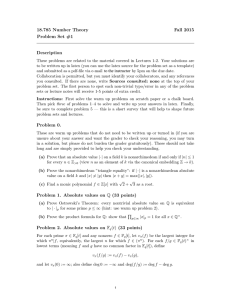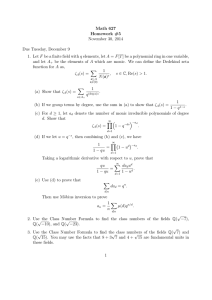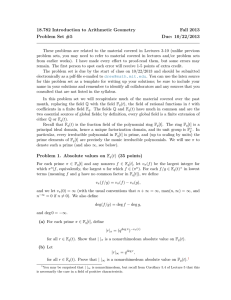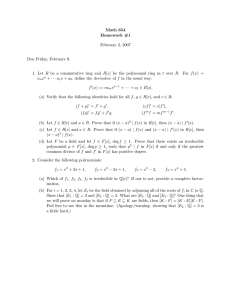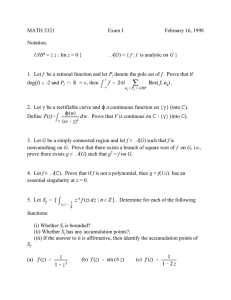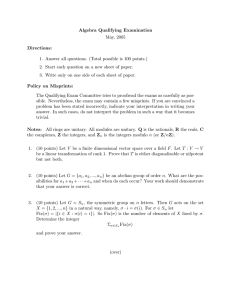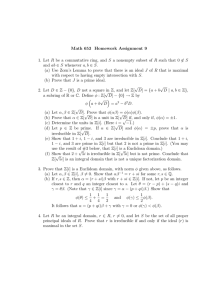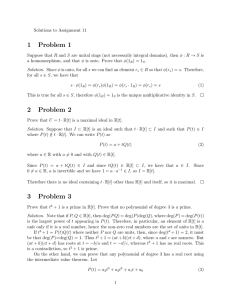18.785 Number Theory Fall 2015 Problem Set #1 Due: 09/21/2015
advertisement
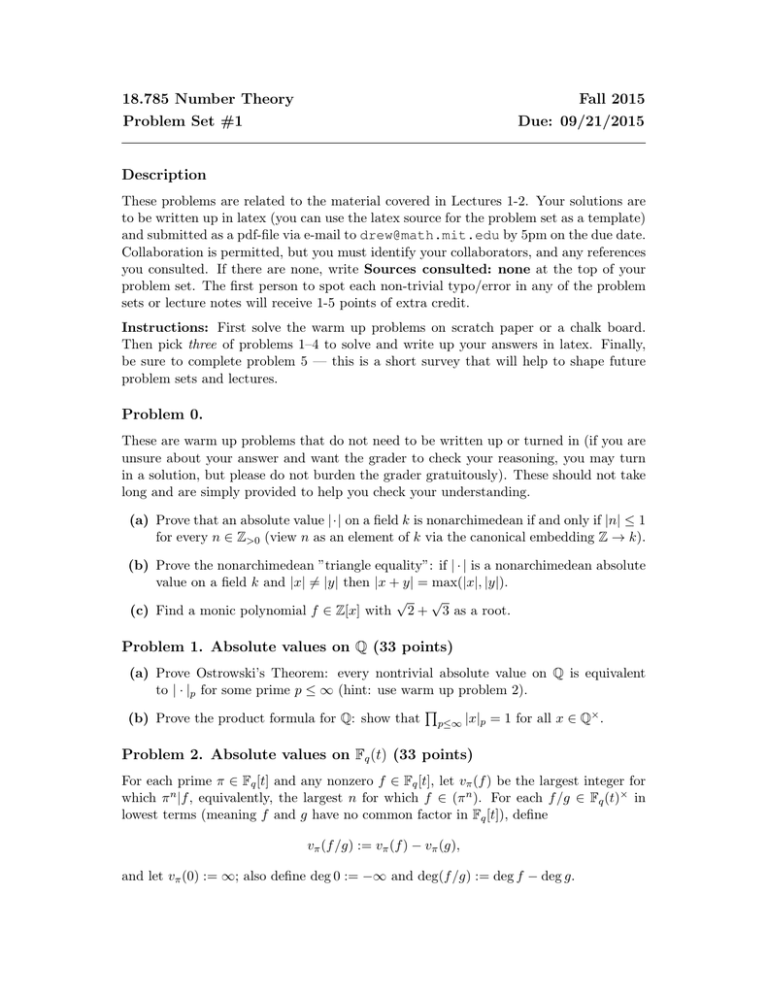
18.785 Number Theory
Problem Set #1
Fall 2015
Due: 09/21/2015
Description
These problems are related to the material covered in Lectures 1-2. Your solutions are
to be written up in latex (you can use the latex source for the problem set as a template)
and submitted as a pdf-file via e-mail to drew@math.mit.edu by 5pm on the due date.
Collaboration is permitted, but you must identify your collaborators, and any references
you consulted. If there are none, write Sources consulted: none at the top of your
problem set. The first person to spot each non-trivial typo/error in any of the problem
sets or lecture notes will receive 1-5 points of extra credit.
Instructions: First solve the warm up problems on scratch paper or a chalk board.
Then pick three of problems 1–4 to solve and write up your answers in latex. Finally,
be sure to complete problem 5 — this is a short survey that will help to shape future
problem sets and lectures.
Problem 0.
These are warm up problems that do not need to be written up or turned in (if you are
unsure about your answer and want the grader to check your reasoning, you may turn
in a solution, but please do not burden the grader gratuitously). These should not take
long and are simply provided to help you check your understanding.
(a) Prove that an absolute value |·| on a field k is nonarchimedean if and only if |n| ≤ 1
for every n ∈ Z>0 (view n as an element of k via the canonical embedding Z → k).
(b) Prove the nonarchimedean ”triangle equality”: if | · | is a nonarchimedean absolute
value on a field k and |x| =
6 |y| then |x + y| = max(|x|, |y|).
√
√
(c) Find a monic polynomial f ∈ Z[x] with 2 + 3 as a root.
Problem 1. Absolute values on Q (33 points)
(a) Prove Ostrowski’s Theorem: every nontrivial absolute value on Q is equivalent
to | · |p for some prime p ≤ ∞ (hint: use warm up problem 2).
Q
(b) Prove the product formula for Q: show that p≤∞ |x|p = 1 for all x ∈ Q× .
Problem 2. Absolute values on Fq (t) (33 points)
For each prime π ∈ Fq [t] and any nonzero f ∈ Fq [t], let vπ (f ) be the largest integer for
which π n |f , equivalently, the largest n for which f ∈ (π n ). For each f /g ∈ Fq (t)× in
lowest terms (meaning f and g have no common factor in Fq [t]), define
vπ (f /g) := vπ (f ) − vπ (g),
and let vπ (0) := ∞; also define deg 0 := −∞ and deg(f /g) := deg f − deg g.
(a) For each prime π ∈ Fq [t], define |r|π = (q deg π )−vπ (r) for all r ∈ Fq (t). Show that
| · |π is a nonarchimedean absolute value on Fq (t).
(b) Define |r|∞ := q deg r , for all r ∈ Fq (t). Prove that | · |∞ is a nonarchimedean
absolute value on Fq (t).
(c) Determine the residue field of Fq (t) with respect to | · |π .
(d) Describe the local ring R = {x ∈ Fq (t) : |x|∞ ≤ 1} and its unique maximal ideal m.
Then determine the residue field of Fq (t) with respect to | · |∞ .
(e) Prove Ostrowski’s theorem for Fq (t): every nontrivial absolute value on Fq (t) is
equivalent to | · |∞ or | · |π for some prime π ∈ Fq [t].
More precisely, show that if k · k is a nontrivial absolute value on Fq (t), either
ktk > 1 and k · k ∼ |˙|∞ , or ktk ≤ 1 and k · k ∼ | · |π for some prime π ∈ Fq [t].
In view of (e) we now regard ∞ as a ”prime” of Fq (t) and let π range over both monic
irreducible polynomials in Fq [t] and ∞.
(f ) Prove the product formula for Fq (t): show that
Q
π
|r|π = 1 for every r ∈ Fq (t)× .
Problem 3. Quadratic fields (33 points)
√
Let K = Q( d) with d 6= 1 squarefree, and let p be a nonzero prime ideal of OK that
does not divide (2d).
(a) Give explicit generators for OK as a Z-lattice.
√
(b) Determine the index of the order Z[ d] in OK as a function of d.
(c) Show that p can be written in the form (p, α), with (p) = p ∩ Z and α ∈ OK .
(d) Show that OK /p ' Fq where q = [OK : p] is either p or p2 , with p = (p, α). Give
an explicit criterion in terms of p and d for when the two cases occur.
Problem 4. Dedekind domains (33 points)
Let A be a Dedekind domain with fraction field K.
(a) Describe all nonzero A-submodules of K.
(b) Describe all subrings of K containing A.
Hint: first think about the case where A is a DVR.
Problem 5. Survey (1 point)
Complete the following survey by rating each problem you attempted on a scale of 1 to 10
according to how interesting you found it (1 = “mind-numbing,” 10 = “mind-blowing”),
and how difficult you found it (1 = “trivial,” 10 = “brutal”). Also estimate the amount
of time you spent on each problem to the nearest half hour.
Interest
Problem
Problem
Problem
Problem
Difficulty
Time Spent
1
2
3
4
Please rate each of the following lectures that you attended, according to the quality of
the material (1=“useless”, 10=“fascinating”), the quality of the presentation (1=“epic
fail”, 10=“perfection”), the pace (1=“way too slow”, 10=“way too fast”, 5=“just right”)
and the novelty of the material to you (1=“old hat”, 10=“all new”).
Date
9/10
9/15
9/17
Lecture Topic
Absolute values
Dedekind domains
Fractional ideals
Material
Presentation
Pace
Novelty
Please feel free to record any additional comments you have on the problem sets and the
lectures, in particular, ways in which they might be improved.
